Trees for the Texas Panhandle
In the early 1930’s the Dust Bowl changed the course of land preservation in most of the western states. The Texas Panhandle was one of those areas damaged by high fierce winds. Because of these damages, many environmental changes took effect. The planting of trees was one of the changes to protect land preservation from damaging winds. This practice changed the environment and resulted in the protection of farm and ranch lands. In modern times, tree planting also added to the beautification of cities. Changes that occurred as a result of tree planting were due largely to the number of dedicated people whose respect for the environment and years of hard work, changed and helped preserve the landscape of this area of Texas.
The following are some of the trees, including some evergreen trees, considered drought-resistant in the Panhandle area. Also consider what type of tree you wish to plant. Tree types include deciduous or evergreen. A tree that drops its leaves and becomes dormant in the winter is a deciduous tree. An evergreen tree will remain green all year and may include a tree with needles or leaves that have broad leaves. Contact Texas Agrilife Extension for a complete list or visit a local nursery in the Panhandle area.
Deciduous Trees
Cedar Elm (40’-60’height, 40’-50’ spread)
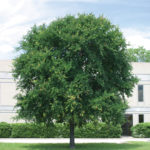
This tree is deep rooted and adapts to heavy soils. It will grow in alkaline or clay soils and in moderation, is wind resistant. Unfortunately while resistant to most insects, damage can be caused by elm leaf beetles. Benefits of this tree include a long life span of up to 100 years, according to the USDA Forest Service. In addition it is shade producing and is an attractive addition to a home landscape. Ulmus crassifolia
Chinese Pistache (30’-40’ height, 20’30’ spread)
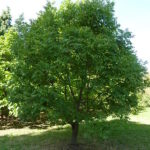
The Chinese Pistache tolerates heat, heavy winds and decreased humidity. It also serves as an excellent landscape tree for lawns. It is a tree with few diseases and is not bothered by most insects. Additional benefits of the Chinese Pistache include giving shade to shrubs that prefer less sun. It is attractive landscape tree for fall showing brilliant red and yellow leaf colors. Pistacia chinensis
Oak Trees
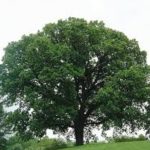
Bur Oak
Examples of oak trees for this area include Texas Red Oak Quercus texana (30’-40’ height, 25’-50 spread), Shumard Oak Quercus shumardii (40’ height, 40’spread), and Bur Oak Quercus macrocarpa (30’-50’ height, 30’-50 spread). Oak trees are slow growing, but when mature, add color and shade to the landscape. The Texas Red Oak is suitable for small yards, while the Shumard and Bur Oak are good trees for larger sites. These oak trees are stress tolerant and disease resistant; however, aphids and spider mites can on occasion attack the Bur Oak.
Honeylocust (40’-50’ height, 30’-40 spread)
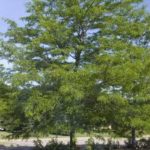
This is a deep rooted tree that tolerates poor alkaline soil. Most of the modern specimens have no thorns and are fruitless. Common names for some of the modern species include Moraine, Majestic, and Shademaster. These are fast growing and are excellent trees for filtered sunlight when planted in lawns. They are drought resistant, deep rooted and tolerate alkaline soil, quite well. Gleditsia triacanthos
Redbud(20’-25’height, 15’-20’spread)
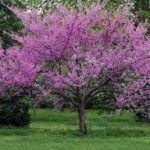
This tree is well adapted to a variety of soils and climates and has lovely purple-red flower. Consider this tree as part of a landscape plan, using it along with other plants. It is especially attractive in a small yard. As the tree reaches maturity it grows slowly. It is also important to place this tree in dry locations and in well-drained soil. All species of the Redbud are subject to the leaf-cutter bee. While this insect is not harmful to the health of the tree, the leaves are damaged and show a frayed or wrinkled appearance. Cercis reniformis is a small redbud with blue-green leaves.
Evergreens
Junipers 30-50’ tall.
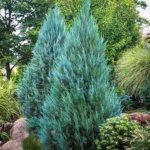
Very useful for privacy or planted as a windbreak. Junipers are also attractive when planted on either side of a walk way. This evergreen is very tough and drought resistant. Plant in full sun. While it is a very hardy, pest such as bagworms and spider mites may be found. There are well over 100 species of this plant. It is important to avoid trimming lower branches of this tree, keeping the growth to the ground. Juniperius with many cultivars.
Colorado Blue Spruce 30’-40’ height. Very slow growing.
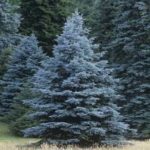
The foliage of this tree is green to blue-green. It is very adaptable in urban settings. This spruce develops well if it is planted away from other trees or shrubs. It requires full sun, but can survive with partial shade. To aid in retaining moisture and cooling soil temperature, it is helpful to apply a mulch of 3-4 inches around the tree. Consider planting away from sprinklers in dry locations. Picea pungens
Pinyon Pine20’-30’ height, 15’20’ spread. Slow grower.

The foliage is dark green to blue-green. It is a tough tree and excellent for hot, dry areas with poor soil and high winds and very little rain fall. It is important for this tree to have good drainage as it does not tolerate wet, heavy clay soils. It is best planted on raised beds or areas with a slight slope. Pinus cembroides (for a more ornamental, try Pinus edulis)
Mondell Pine 30’40’ height, 25’-30’ spread.
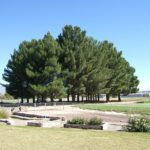
A Dense pine often used as a fine textured screen. May be planted in groups or a single tree in open areas. Needs full sun and well-drained soil. Thrives well in alkaline or clay soil. Grows well in desert-like conditions and grows rapidly when young. Pinus eldarica